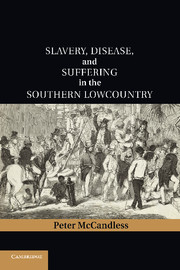Book contents
- Frontmatter
- Contents
- List of Figures
- List of Maps
- Preface
- Acknowledgments
- List of Abbreviations Used in Notes
- MAP 1 The Lowcountry, Charleston, and the Caribbean region
- MAP 2 The South Carolina lowcountry, showing Anglican parishes and slave proportion of population, c. 1760s
- MAP 3 Charleston Harbor, based on a British map, c. 1780
- MAP 4 The Revolutionary War in the South
- PART I TALK ABOUT SUFFERING
- 1 Rhetoric and Reality
- 2 From Paradise to Hospital
- 3 “A Scene of Diseases”
- 4 Wooden Horse
- 5 Revolutionary Fever
- 6 Strangers' Disease
- 7 “A Merciful Provision of the Creator”
- PART II COMBATING PESTILENCE
- Bibliography
- Index
- References
1 - Rhetoric and Reality
Published online by Cambridge University Press: 03 May 2011
- Frontmatter
- Contents
- List of Figures
- List of Maps
- Preface
- Acknowledgments
- List of Abbreviations Used in Notes
- MAP 1 The Lowcountry, Charleston, and the Caribbean region
- MAP 2 The South Carolina lowcountry, showing Anglican parishes and slave proportion of population, c. 1760s
- MAP 3 Charleston Harbor, based on a British map, c. 1780
- MAP 4 The Revolutionary War in the South
- PART I TALK ABOUT SUFFERING
- 1 Rhetoric and Reality
- 2 From Paradise to Hospital
- 3 “A Scene of Diseases”
- 4 Wooden Horse
- 5 Revolutionary Fever
- 6 Strangers' Disease
- 7 “A Merciful Provision of the Creator”
- PART II COMBATING PESTILENCE
- Bibliography
- Index
- References
Summary
Black and white all mixed together,
Inconstant, strange, unhealthful weather
Burning heat and chilling cold
Dangerous both to young and old
Boisterous winds and heavy rains
Fevers and rheumatic pains
Agues plenty without doubt
Sores, boils, the prickling heat and gout
Mosquitoes on the skin make blotches
Centipedes and large cockroaches…
Water bad, past all drinking
Men and women without thinking…
Many a widow not unwilling
Many a beau not worth a shilling
Many a bargain if you strike it,
This is Charles-town, how do you like it?
Capt. Martin, captain of a Man of War, 1769[Charleston] is a noble monument of what human avarice can effect; its soil is a barren burning sand; with a river on either side, overflowing into pestilential marshes, which exhale a contagion so pernicious as to render sleeping a single night within its influence, during the summer months, an experiment of the utmost hazard … But what will not men do, and bear, for money? These pestilential marshes are found to produce good rice, and the adjacent alluvions cotton; true, it is, no European frame could support the labour of cultivation, but Africa can furnish slaves, and thus amid contagion and suffering, both of oppressors and oppressed, has Charleston become a wealthy city – nay a religious one, too; to judge by the number of churches built, building, and to be built.
Francis Hall, 1817- Type
- Chapter
- Information
- Publisher: Cambridge University PressPrint publication year: 2011



